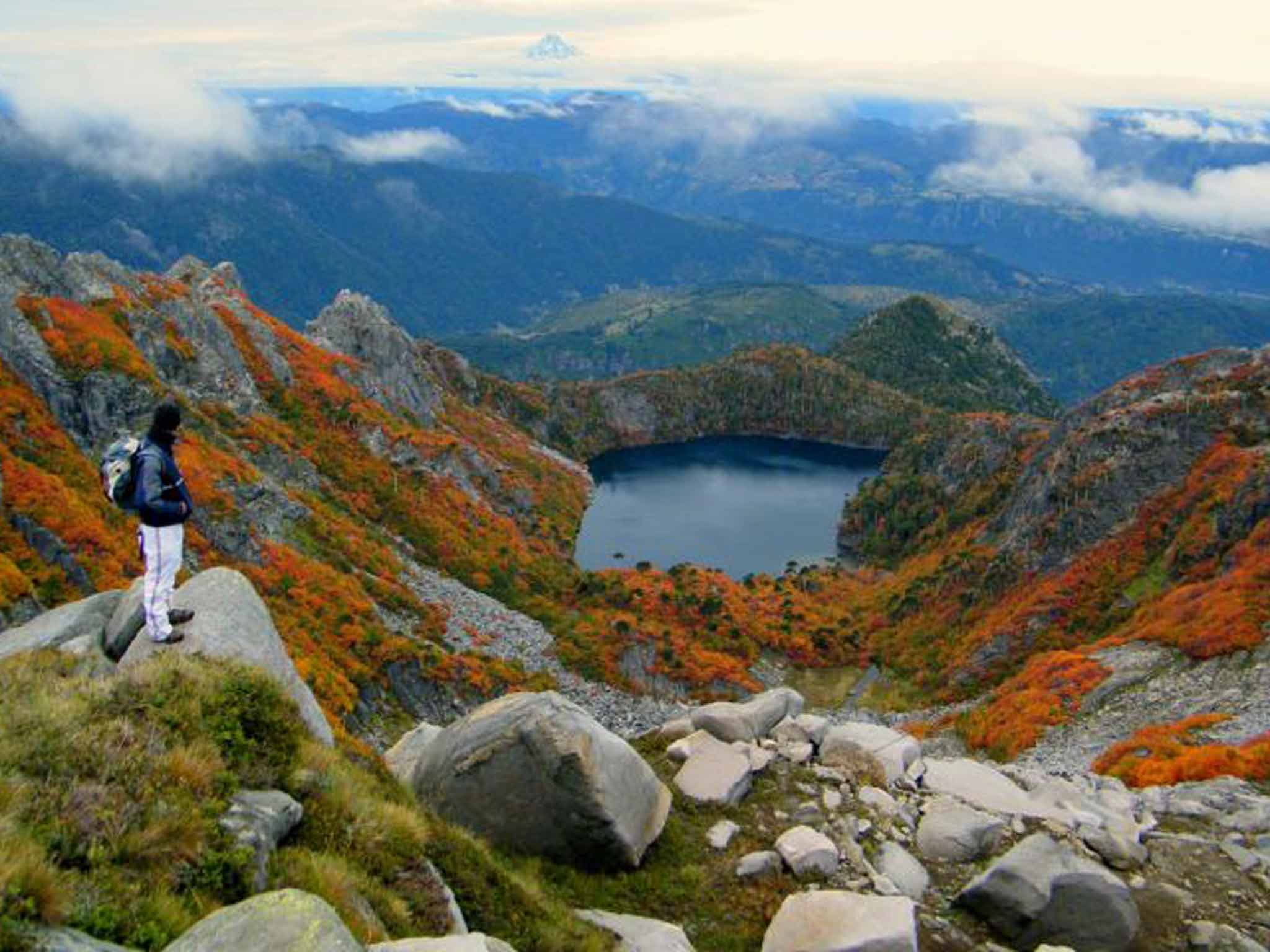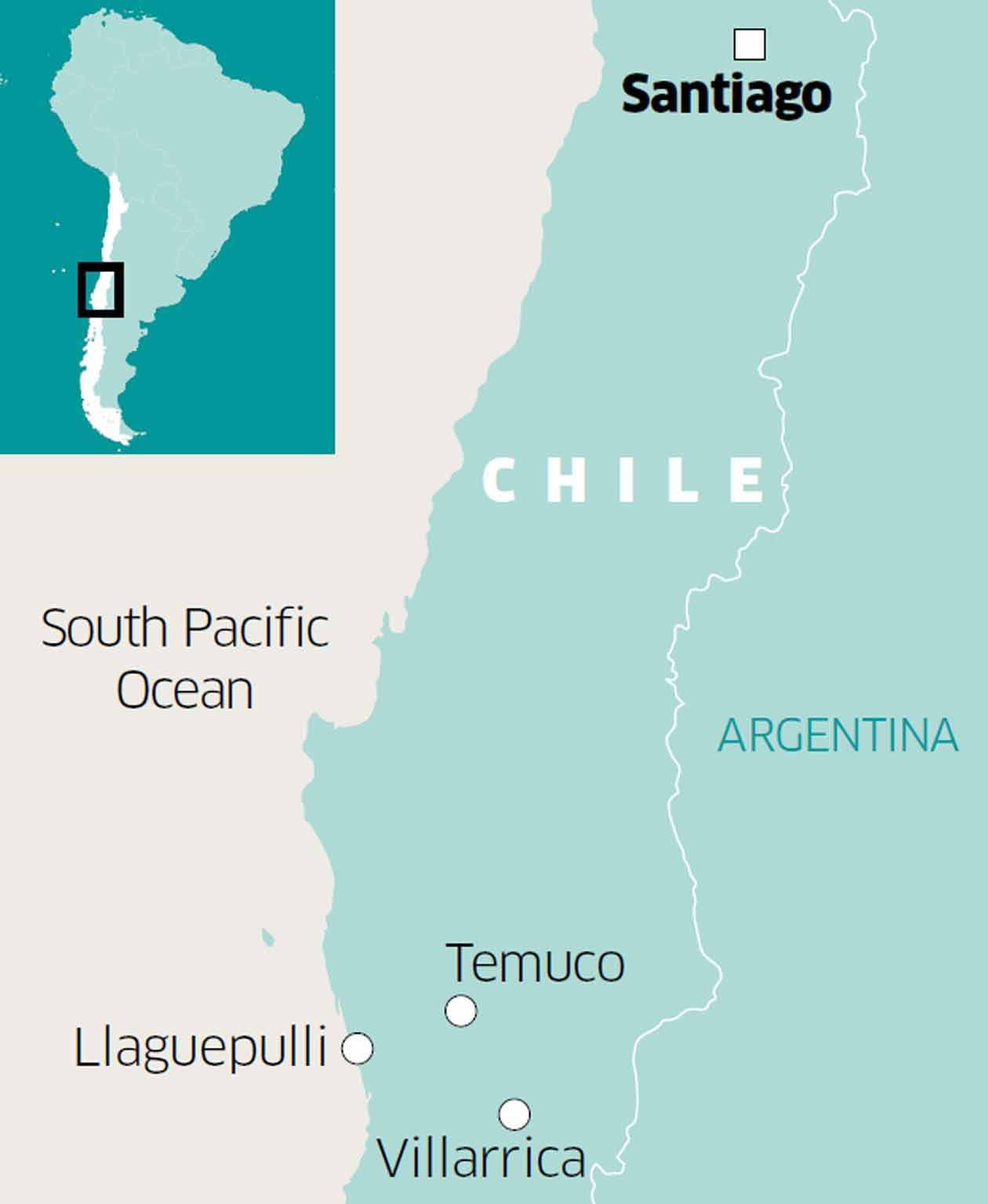Chilean Lake District: A land where the familiar is made strange
At first sight, this region looks much like our own but, after forays into the mountains and out to the coast, Jeremy Laurance is charmed by its unique beauty

Your support helps us to tell the story
From reproductive rights to climate change to Big Tech, The Independent is on the ground when the story is developing. Whether it's investigating the financials of Elon Musk's pro-Trump PAC or producing our latest documentary, 'The A Word', which shines a light on the American women fighting for reproductive rights, we know how important it is to parse out the facts from the messaging.
At such a critical moment in US history, we need reporters on the ground. Your donation allows us to keep sending journalists to speak to both sides of the story.
The Independent is trusted by Americans across the entire political spectrum. And unlike many other quality news outlets, we choose not to lock Americans out of our reporting and analysis with paywalls. We believe quality journalism should be available to everyone, paid for by those who can afford it.
Your support makes all the difference.Stepping off the plane at Temuco airport, 370 miles south of Santiago, I was struck by the softness of the air after the dessicating dryness of the Atacama desert from where I had just arrived. It was like an English summer's day – warm sun, green trees swaying gently in the breeze – it felt like coming home.
Temuco is the capital of Araucania, the Chilean Lake District, and it was not only the name that was familiar. The hills, lakes and forests of this region are almost indistinguishable from their English counterparts, save for the addition of the odd snow-capped volcano.
It was the ideal destination for some relaxation after the rigours of the desert, delivering everything the walker, birdwatcher or adrenalin junkie could want – with a distinctive Chilean twist. Yet few foreign tourists visit the area, compared with the hordes who fly over it en route to the mountains and glaciers of Patagonia to the south or the salt flats and desert rock formations in the Atacama further north. These are the extremes that this narrowest of countries has to offer – over 2,000 miles in length but no more than 150 miles wide, squeezed between the rugged Andes to the east and the Pacific ocean to the west.
It was Chilean autumn and Temuco's warm, sunny streets were packed with shoppers bustling around the pricey stores and slick office blocks. But soon after I turned off the main drag, the smart streets became suddenly shabbier and the modern city turned into a frontier town. I passed a butcher's advertising horse meat, hardware shops and motor supplies, before stopping outside a nondescript building with a crumbling façade. It was Pablo Neruda's home till he was 16, but there was no plaque outside. The owners of the house that once belonged to the family of the Nobel prize-winning poet had it removed because it attracted too much attention.
I stopped for lunch at one of the many bustling restaurants close to the magnificent fruit and vegetable market, a technicolour display stretching for a hundred yards. As shoppers laden with bags jostled for a table, I ordered pastel de choclo – a sweet and filling bowl of meat, onion, olives and hardboiled egg topped with a thick layer of ground yellow corn and baked in the oven. Afterwards, at the Railway Museum, I relived childhood adventures among one of the finest collections of steam locomotives in the world before climbing to Cerro Ñielol, a forested oasis on a hill above the city where in 1881 the Mapuche Indians ceded ownership of the land to the occupying forces of the Chilean military who founded Temuco.
The following day I travelled an hour west to a Mapuche village near the Pacific coast at Llaguepulli. Araucania is the heartland of this ethnic group, a fierce and proud people who halted the advance of the Spanish conquistadors in the 16th century. Today they are a marginalised, poor, mainly farming community. The rukas – traditional thatched huts in which I was to spend the night – were situated on a hill overlooking a lake, surrounded by farmsteads with turkeys, llamas, and little brown piglets running free.
Ibis honked amid the eucalyptus trees as I wandered around picking blackberries. It was a beautiful, tranquil spot and lunch was served in the communal hut – a lean steak, tender and succulent – with what looked like three long sausages but turned out to be a delicious local potato. When darkness fell, the temperature plummeted and I sat by a smoky fire while Maurizio, the local chief, explained his plan to rescue his community with the aid of the tourist dollar. In the small hours I turned my head to the sky. The Milky Way was brighter than I have ever seen it, like spilt sugar strewn across the heavens.
The Mapuche project has been running just five years and, it seems to me, has some way to go if it is to become the tourist attraction that its creators hope. I wanted Maurizio, the chief, to tell us about their way of life, how they lived, what they farmed, whom they married, how they raised their children. Instead he described how he spotted a business opportunity: getting outsiders to pay to sleep in conditions most Mapuche have long since rejected. But his idea still has to catch on in his own community. Out of 80 families, just 18 participate in the scheme, renting out accommodation.
From Llaguepulli, I continued west to the coast, the smell of brine in my nostrils, the cool breeze from the Humboldt current blowing away the smokiness of my night in the ruka. Seals danced through the surf on Playa Maule, the long beach at the fishing port, Puerto Saavedra.
After lunch in a seaside restaurant, I got to test one of Araucania's claims that you can be on the beach in the morning and in the mountains – with rafting, fishing and volcano climbing – by the afternoon.
Leaving the beach around 3pm, I travelled by road to Pucón and the Hotel Antumalal, perched on a cliff under the Villaricca volcano overlooking the lake of the same name. My pisco sour reached me on the terrace, suspended above the gardens that run steeply down to the wooded shore, just as the sun was about to dip below the horizon. Buff-necked ibis with their long curved bills pecked at the manicured lawns, and southern lapwings shrieked in the air above the trees. After the predations of the previous night, this was bliss.
Hotel Antumalal – "corral of the sun" in Mapuche – was built 60 years ago in the Bauhaus style, and its elegant, light-filled rooms still feel modern. A photo in the hallway remembers Queen Elizabeth and the Duke of Edinburgh's visit in 1968.
A log fire was burning as I ate carrot and beetroot soup – a glorious colour combination – and rib eye steak. The hotel, with its beach and spa and carefully tended garden, was quiet, so I retreated to my room where another fire kept me toasty through the night.
The following morning I met Roberto, a leather-jacketed representative of the local tourist board. His grandfather had owned 5,000 hectares of land in the 1960s and had all but 800 seized by Allende. "I am not political. I am about nature," he told me.
Pucón is a charming resort with flower-lined streets and smart shops and restaurants. It was sunny but clouds were draped over Villaricca, the live volcano that dominates the town, and by evening there would be claps of thunder overhead.
While the sun still shone, I visited the Ojos del Caburgua (the Eyes of Caburgua) – a waterfall deep in the woods – and three irridescent blue pools fed from underground springs, all within 30 minutes' drive of Pucón. Roberto next delivered me to the Huife hot springs – another 30-minute drive – a high-end complex of pools, restaurants and accommodation, which he part owns. I tried each of the three pools, and managed two minutes in each – too hot for me – but there were plenty of Chilean families lolling about in the steamy water.
After a delicious lunch of cazuela, a traditional dish of neck of lamb cooked in a clear broth with carrots, beans, corn and potato, I headed back to Temuco for the last leg of my journey: a visit to a remote camp, high up in the mountains.
Robert, the 25-year-old son of the camp's owner, drove at startling speed in his battered pick-up along switchback roads on the two-hour journey. The road crumbled into a dirt track that crossed pasture and then forest between rugged hills. We passed farmsteads, cows, sheep, and horses. The track turned and spiralled upward, climbing 1,000 metres to an escarpment. The country grew steadily wilder, unfenced, with huge boulders, dead and dying trees strewn with lichen and wisps of old man's beard. We arrived suddenly at the camp, Nevados de Sollipulli, which consisted of half a dozen yurt-like domes by a small lake. It was surrounded by araucania trees, the endemic, Chilean national emblem, their spiky branches curling upward like prehensile limbs.

In spite of their transient appearance, the domes were built of fibreglass with wood walls, stone floors and central heating. The bed was firm and the duvet soft and thick. Later, I lay in bed and listened in blissful comfort to the rain beating down outside.
The central dome, which looked like a space station from the outside, was furnished with sofas, a bar and dining table arranged around an open fire. There is a sauna and hot tub which I took advantage of the next day, broiling gently as big spots of rain fell around me.
Here is Chile's wild west and the means to explore it. There are quad bikes, snowmobiles, skis, helmets for canyoning, snowshoes and camping gear for expeditions up on to the huge crater of the extinct Solipulli volcano. Christian, Robert's father who established this outpost almost a decade ago, was a captain in the army during the Pinochet era and was posted to Tierra del Fuego in Patagonia where he gained a taste for the wilderness.
The next morning I climbed with Robert up a steep track into the forest. It grew eerie as we ascended, the Araucania trees dripping with old man's beard, as though it had dropped from the heavens. The trees are up to 1,000 years old and it was piñon season – the fat seedpods, which look like pointed chestnuts, fell at our feet as we walked.
We reached the tree line but the cloud was low and we had to turn back. An hour later it started to rain again, and I lolled in the outdoor hot tub, as the steam rose in to the dripping trees. Nevados de Sollipulli is the strangest, most beguiling spot. It felt like the end of the world. The region that had seemed so familiar at the start of my visit turned out to be like nowhere else at the end.
Getting there
Cox & Kings (020 7873 5000; coxandkings.co.uk) offers group and private tours to Chile. An eight-day trip around Araucania costs from £2,945pp, with flights via Madrid, B&B, transfers and private excursions. For more information on Chile, see chile.travel
Join our commenting forum
Join thought-provoking conversations, follow other Independent readers and see their replies
Comments